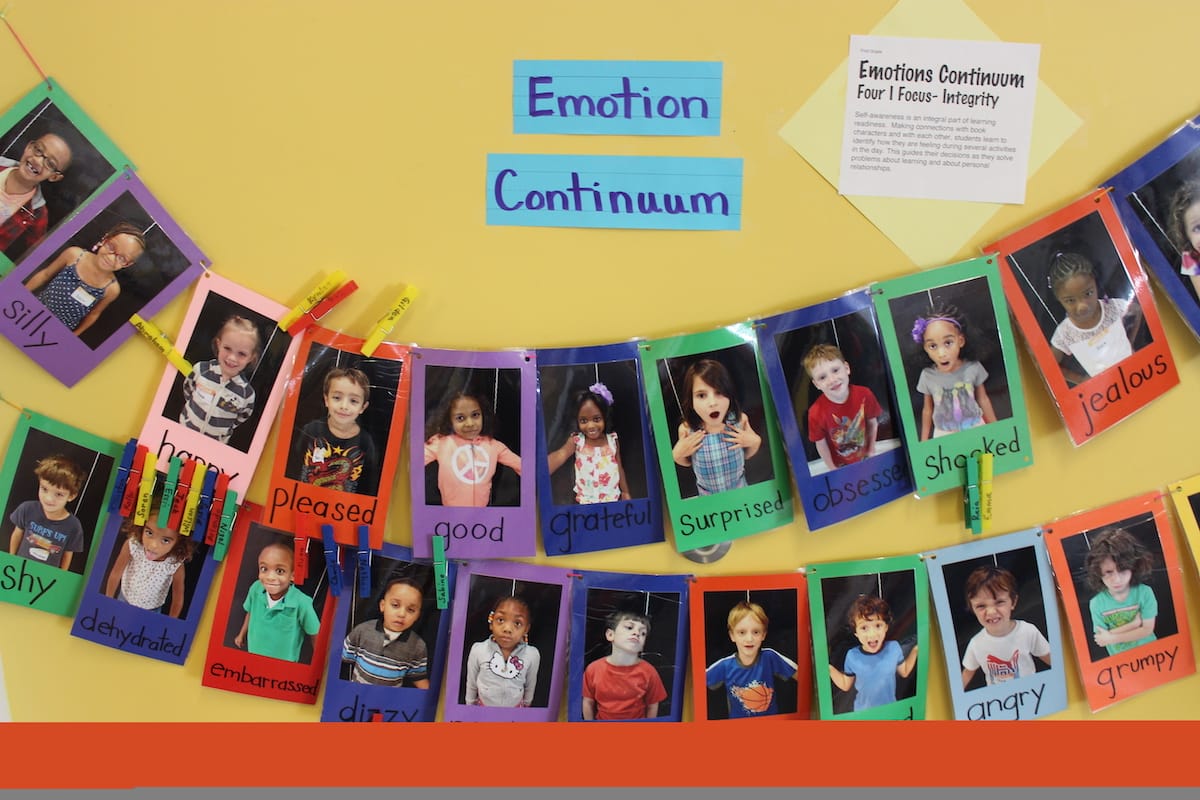If you try this activity with your students, we’d love to see what you do. Share your journey via the #Inspired2Learn hashtag on your preferred social platform.
Discipline: These activities can be applied in any class or subject area though they do not have direct ties to content. With some creative thinking, you can make those connections by choosing prompts or actions related to what you are teaching that day.
Age level: All
Time: 3–5 minutes (The Emotion Continuum takes at least one class period to create but after that, it can be used for just a minute a day.)
When students enter the room they come with all sorts of feelings and those feelings can be big and influential on both the student and their peers. Gauging the temperature of the room right off the bat can give you a better idea of what you’re working with. Here are a few tools for doing that.

Emotion Continuum
Research proves that self-regulation and empathy are teachable skills essential to success in the classroom and in the 21st century workforce. While activities that build social-emotional skills are traditionally relegated solely to the younger years, people of all ages benefit from an environment that supports their emotional needs and development. Through this challenge, students build their vocabularies and build productive strategies for communicating feelings and needs to adults and to one another.
- They work together to create an “emotion continuum” which is essentially a wall of pictures that represent the wide range of emotions one can feel.
- They spend time as a group thinking about how these emotions can be organized and posting them somewhere accessible in the room.
- Then each day when they come to class throughout the year they have a clothespin with their name on it that they can clip to the emotion that best represents how they’re feeling that day. A quick visual check of the continuum can give you a good indication of how your students are feeling on any particular day.
You can find full instructions for this activity here.
Emotional Metaphor
You can start class with a question that students write, draw or respond to verbally asking them to share how they’re feeling through a metaphor. The prompt looks like this: If your feelings right now were a _____ what would you be and why?
You can fill the blank with many different things, here are a few examples:
- Color
- Food
- Season
- Piece of clothing
- Animal
- Time of Day
This can be an interesting way to help your students reflect on their own feelings and if you have a classroom full of crocodiles you know you might need to shift your lesson a bit to offer space for wrestling with what’s going on.
How Full is Your Cup?
It takes a lot of energy to be a learner and students don’t always come to class with everything they need to be fully engaged. You cannot pour from an empty cup! This wellness checkup provides a simple visual way to reflect on what students have to give and what they need to fill them up. It can be helpful for personal reflection and a quick walk around the classroom as students fill it out can give you a good visual of where your students are at the start of class. You might also create a smaller version for an exit ticket and see how they feel as class comes to a close!
Inspired Teaching Connection:
These activities are all grounded in Mutual Respect because they take the time to get to know how students are feeling, centering their experiences in the classroom environment. In this way they also address the 4 I’s, engaging students’ Intellects, Inquiry (by delving into how they and others feel), Imagination (through metaphor and imagery), and Integrity (caring for themselves and one another).
See our instructional model here.
Standards Addressed by this Activity
Common Core College and Career Readiness Anchor Standards for Language
Conventions of Standard English:
CCSS.ELA-LITERACY.CCRA.L.1 Demonstrate command of the conventions of standard English grammar and usage when writing or speaking.
Knowledge of Language:
CCSS.ELA-LITERACY.CCRA.L.3 Apply knowledge of language to understand how language functions in different contexts, to make effective choices for meaning or style, and to comprehend more fully when reading or listening.
Common Core College and Career Readiness Anchor Standards for Writing
Text Types and Purposes:
CCSS.ELA-LITERACY.CCRA.W.3 Write narratives to develop real or imagined experiences or events using effective technique, well-chosen details and well-structured event sequences.
Collaborative for Academic, Social, and Emotional Learning Competencies
Self-Awareness: The abilities to understand one’s own emotions, thoughts, and values and how they influence behavior across contexts. This includes capacities to recognize one’s strengths and limitations with a well-grounded sense of confidence and purpose.
Self-management: The abilities to manage one’s emotions, thoughts, and behaviors effectively in different situations and to achieve goals and aspirations. This includes the capacities to delay gratification, manage stress, and feel motivation and agency to accomplish personal and collective goals.
Social awareness: The abilities to understand the perspectives of and empathize with others, including those from diverse backgrounds, cultures, and contexts. This includes the capacities to feel compassion for others, understand broader historical and social norms for behavior in different settings, and recognize family, school, and community resources and supports.
Responsible decision-making: The abilities to make caring and constructive choices about personal behavior and social interactions across diverse situations. This includes the capacities to consider ethical standards and safety concerns, and to evaluate the benefits and consequences of various actions for personal, social, and collective well-being.
Relationship skills: The abilities to establish and maintain healthy and supportive relationships and to effectively navigate settings with diverse individuals and groups. This includes the capacities to communicate clearly, listen actively, cooperate, work collaboratively to problem solve and negotiate conflict constructively, navigate settings with differing social and cultural demands and opportunities, provide leadership, and seek or offer help when needed.
